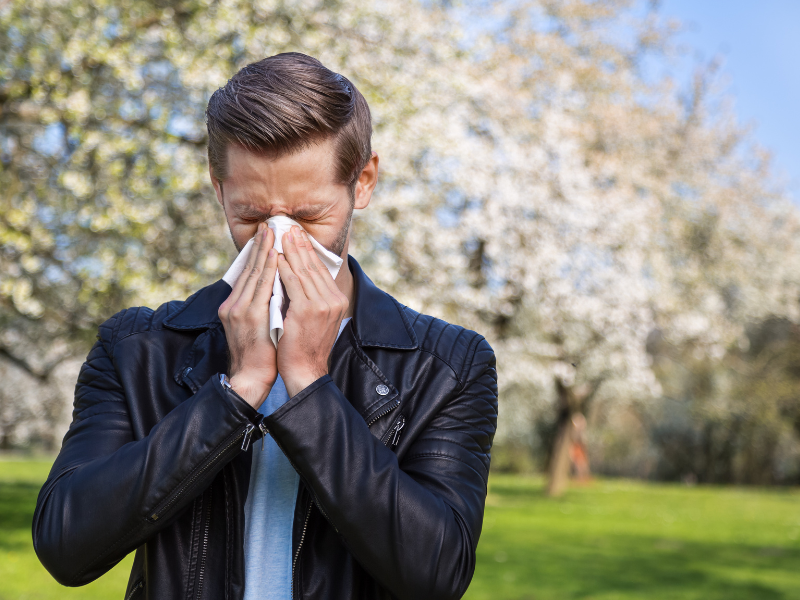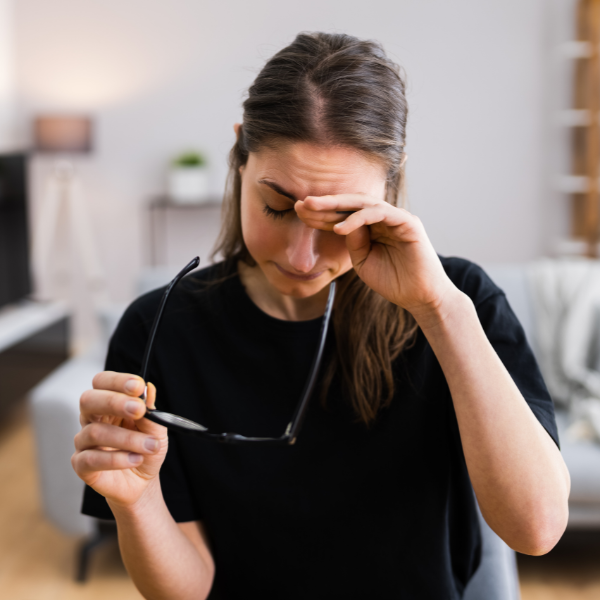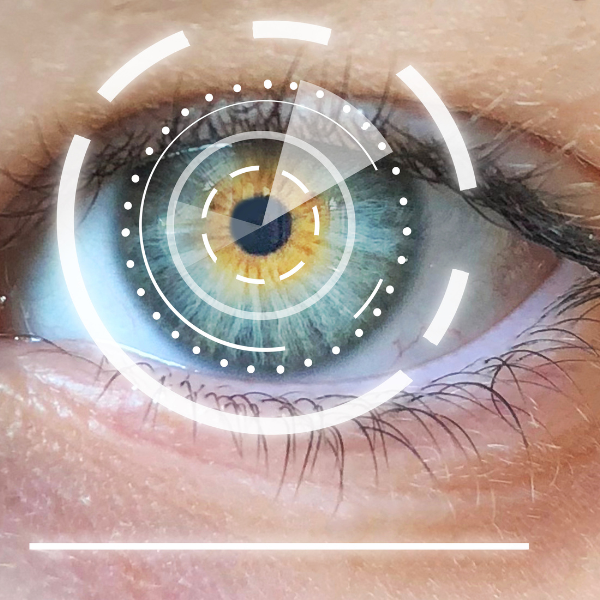How your optometrist can help your hay fever
The irritation, itchiness and watery eyes that hay fever brings in the spring and summer seasons can be frustrating and affect your lifestyle. The constant rubbing can also lead to dryness and redness. Here’s how an optometrist can help you manage these symptoms of hay fever.
1.Non-prescription eye drops
Your optometrist can recommend over the counter eye drops depending on the symptoms and severity of your hay fever in relation to your eyes.
2. Prescription eye drops and medication
There are different types of prescription eye drops that an optometrists can provide for severe allergies such as antihistamine and anti-inflammatory eye drops.
3.Oral Antihistamines
In conjunction with eye drops, your optometrist may also recommend oral antihistamines to hep relieve hay fever symptoms.
Some other ways that you can help reduce the effect of hay fever on your eyes include:
- Wearing sunglasses when outside
- Use a dehumidifier in the house
- Keep your windows closed on high pollen days
- Wash your hands after exposure to pets, grass and other flora.
If you would like to discuss your options to treat the symptoms of hay fever in relation to your eyes, contact your optometrist today.
How your optometrist can help your hay fever
The irritation, itchiness and watery eyes that hay fever brings in the spring and summer seasons can be frustrating and affect your lifestyle. The constant rubbing can also lead to dryness and redness. Here’s how an optometrist can help you manage these symptoms of hay fever.
1.Non-prescription eye drops
Your optometrist can recommend over the counter eye drops depending on the symptoms and severity of your hay fever in relation to your eyes.
2. Prescription eye drops and medication
There are different types of prescription eye drops that an optometrists can provide for severe allergies such as antihistamine and anti-inflammatory eye drops.
3.Oral Antihistamines
In conjunction with eye drops, your optometrist may also recommend oral antihistamines to hep relieve hay fever symptoms.
Some other ways that you can help reduce the effect of hay fever on your eyes include:
- Wearing sunglasses when outside
- Use a dehumidifier in the house
- Keep your windows closed on high pollen days
- Wash your hands after exposure to pets, grass and other flora.
If you would like to discuss your options to treat the symptoms of hay fever in relation to your eyes, contact your optometrist today.
Top tips for better vision while driving at night
As winter arrives, driving at night becomes a more common occurrence. As a result, so do many of the common symptoms associated with night driving.
You know the feeling – tired eyes, haloes around street lights, sudden glare of oncoming traffic and wet, shiny streets.
With fatal accidents three times more likely to happen at night1, considering options for better vision when night driving can be very useful.
As we age, our pupils naturally become smaller. As a result, less light is able to enter the eye. This affects our colour recognition, our concept of how far away things are and reduces our side or peripheral vision.
Here are some helpful tips that can help to improve your night vision:
- Keep your glasses and the windscreen clean. Marks on either surface can create a halo effect around oncoming lights.
- Dim your dashboard lights
- Ensure you wear anti-reflective lenses as they allow more light to pass through to your eye, helping you to see more clearly. Standard lenses will reflect light, increase glare and reduce light transmission by almost 10%.
The importance of sunglasses during winter
Did you know that your eyes are susceptible to sunburn all year round? In fact, you may be at greater risk of damaging your eyes during the cooler months. Optometry Australia’s 2020 Vision Index revealed that over 75% of Australians don’t think that UV protective sunglasses are necessary for the winter months however this couldn’t be further from the truth.
Australia has one of the highest exposure levels of Ultraviolet (UV) Radiation in the world. UV radiation is emitted by the sun and exists in three forms:
- UVA – not absorbed by the ozone layer at all
- UVB – about 15% of UVB transmits through to the earth’s atmosphere
- UVC – absorbed by ozone and does not reach the earth’s surface
In terms of eye damage, it’s UVA and UVB rays that are concerning. 90% of UV radiation can penetrate clouds and that exposure can sometimes be made more intense due to reflections off these clouds. As the sun sits lower on the horizon in the winter months we are actually more exposed to those damaging UV rays, as they directly enter the eyes.
Another interesting fact is that UV exposure to the eyes is maximised between 8am to10am and 2pm to 4pm when the sun is lower in the sky often making these the most important times to be wearing your sunnies to protect from UV and give comfort from glare.
Eye problems arising from UV exposure
Too much winter sun without protective eyewear can potentially lead to:
- Photokeratitis – this is typically experienced by those who spend time in the snow and is often called snow blindness. The exposure to high doses of UV causes the cornea to become sunburnt.
- Cataracts – clouding of the eye leading to blurred and distorted vision
- Pterygium – typically experienced by surfers from overexposure to UV rays reflecting off the water’s surface. It results in a fleshy white-pink growth that can invade the cornea and disfigure the eye.
Sunglasses – a practical and fashionable solution
If you want to protect your eyes all year round (and you should!), simply wear a pair of quality sunglasses and in summer add a wide brim hat. If possible, look for lenses that are polarized as they offer greater protection as they cut down more reflections. All sunglasses sold in Australia must be tested and labelled according to the Australian Standards. This standard sets limits for the allowable UV transmission of sunglasses for adults and children. Your sunglasses should have a lens UV rating of at least 3. To know what the UV level is where you live, use the SunSmart app for live updates.
We offer a range of sunglasses to cater to your lifestyle needs. Whether it’s prescription sunglasses allowing you to see clearly when you’re outdoors or plano sunglasses if you’re a contact lens wearer or simply don’t require a prescription – we’ve got you covered.
Enhancing your lifestyle with contact lenses: FAQ
For those of you considering trying out contact lenses to enhance your lifestyle, here are some answers to frequently asked questions about contact lenses.
Can anyone use contact lenses?
Most people are eligible to use contact lenses. However, there are some prescriptions that are not suitable for contact lenses. It is best to check with your optometrist if contact lenses are right for you.
How long does it take for your eyes to get used to contacts?
It can take up to two weeks for your eyes to adjust to contact lenses. While your eyes adjust you may experience blurred vision and find yourself blinking more often than usual. The more you wear your contacts the quicker your eyes will adjust.
Can contact lenses get lost behind your eye?
Good news – it is impossible for the contact lens to get behind your eyeball and become trapped.
What is the difference between daily and extended wear contact lenses?
Daily wear contact lenses are disposed of daily after use. The benefit of daily wear contact lenses is there is no need to clean the lenses or by any solution as the lenses get disposed of after use.
Extended wear contact lenses can be worn anywhere from one week to one month depending on the type of contact. Extended wear contacts require a cleaning regimen to care for the contacts.
Can I sleep with contact lenses in?
Majority of contact lenses are not suitable to sleep in. There are some contact lens options that are approved for overnight use. It is bet to talk to your optometrist about which option is right for you.
Can I use contact lenses while playing sports?
Absolutely. One of the big advantages of wearing contact lenses is being able to use them while playing sport or when engaging in other physical activity. However it is not recommended to use contact lenses while swimming.
Do contact lenses expire?
Yes, they do. Even if the contacts haven’t been opened, they could still have expired. Make sure to always check the packaging for the expiration date.
How often do I need to update my contact prescription?
In Australia, contact lens prescriptions are valid for a maximum of 12 months. If your prescription is older than one year, it’s time for an eye test.
If you are interested in trying out contact lenses – make an appointment with one of our optometrists today to discuss which options are right for you.
Diagnosing Dry Eye Syndrome
Our eyes are the most sensitive and easily disturbed part of your body. Even with slight irritation, they may start watering. Therefore, we have to take extra care in order to maintain eye health and prevent inflammation, especially with aging. It is therefore important to understand the symptoms of dry eye syndrome, and how it should be treated.
Tears & Why They’re Important
The eyes produce tears to remove irritants and to keep our eyes lubricated. Tears are made up of:
- Mucus
- Oil
- Antibodies
- Water
The above-quoted ingredients come from special glands around your eyes. An excess tear-flow from your eyes can occur due to poor tear drainage or overproduction of tears. Watery eyes are often not harmful but can be the cause of irritation. Alternatively, dry eye condition means that glands around the eyes aren’t working properly, and cannot adequately moisturise the eye.
What Happens If Tears Don’t Work Properly?
The production of tears is a natural cleaning mechanism, flushing away foreign objects that may come into contact with the eye easily. With the dry eye syndrome, the eye can not remove irritants effectively, and one of the two things can happen; insufficient or excessive production of tears. Inadequate production of tears may cause:
- Redness
- Irritation
- Continuous discharge of mucus
- Swelling
- Blurred vision
- Light sensitivity
If your eyes drops out water continuously, the result is often Reflex Tearing. This is because your eyes will send a distress signal to your nervous system to have the eyes lubricated to overcome the irritation and dryness. And as a result, excessive tear production will start.
Causes Of Dry Eye Syndrome?
There are many reasons described by science for this syndrome. However, the main ones are:
- An unbalanced tear flow system
- Dried tear film
- Drug-induced side effects
- Natural aging process
- Menopause
- Sjogren’s syndrome
- Rheumatoid arthritis
- Collagen vascular diseases
- Lagophthalmos
- Blepharitis
- Uneven eyelids
- Long-term use of contact lenses
How Is The Syndrome Diagnosed?
You need to go through a comprehensive eye examination to determine the exact quality and quantity of your tears that are produced. Furthermore, your doctor will go through some more procedures to determine the exact cause of the syndrome, and those tests will include:
- General medical history to note the symptoms and health problems
- Environmental causes and age factor that may add more to dry eye condition
- External assessment of the eye like the eyelid structure and blink dynamics
- Eyelid and cornea evaluation with bright light and magnifying glasses
- Tear abnormality along with quality and quantity difference
- Insertion of special dyes will be performed to observe the tear flow along with changes in the outer surface
Once your optometrist/doctor performs all of the above tests, then he/she will be suggesting the best treatment based on the current situation to smoothen out your dry eye condition.
Various Types Of Treatments For Dry Eyes
There are a lot of treatments available for treating dry eye syndrome. However, here are a few that your healthcare provider will prescribe depending on the severity of your condition. These are:
- Artificial ointments and teardrops
- Conserving tears
- Non-dissolving punctal plugs
- Punctal occlusion by cautery
- Lipiflow
- Temporary Punctal occlusion
- Cequa
- Testosterone cream
- Lifitegrast
- Xiidra
- Fish oil
These solutions are not to be administered without an expert optometrist’s prescription and advice. Visit us today to book your eye test consultation with our expert doctors and optometrist.
Macular Focus in May
May is Macula month, a campaign centred around the education and awareness of macular disease.
The macula is responsible for detailed central vision, meaning we use it for activities such as reading, driving and recognising faces. It’s also responsible for most of your colour vision, so its quite shocking to learn that an estimated 1.7 million Australians have some evidence of macular disease.
Macular disease covers a range of painless conditions affecting the central retina which can be found at the back of the eye.
Conditions only affecting the macula don't lead to total blindness, instead, they impact central vision, leaving peripheral vision intact.
SYMPTOMS OF MACULAR DISEASE
You can have early signs of macular disease without knowing it. However, when symptoms do appear, they can include:
- Difficulty with reading or any other activity which requires detailed central vision (despite wearing appropriate glasses)
- Distortion, where straight lines may appear wavy or bent
- Problems distinguishing faces
- Dark patches in the central vision
- Macular disease can affect anyone, at any age, so knowing your risks, and having regular macula checks, is the only way to protect your vision.
But how do you know if you are at risk ?
Take the 'Check My Macula' quiz and in one minute, you’ll have a better idea of your risk factors.
Take Quiz
So, if you've just taken the quiz and have any vision concerns that you think might need attention, please contact us to make an appointment or visit us online.
How can the cold affect your eyes?
One of the most common patient complaints during the winter months is dry eyes. Cold and windy weather conditions can reduce the natural moisture in your eyes resulting in a burning or itching sensation.
 Dry eye is a common visual condition which affects one in four people worldwide and is more likely to occur in women and the elderly. The medical name for dry eye syndrome is keratoconjunctivitis sicca. Symptoms can include burning, scratchiness or irritation, redness, watering and even blurred vision. Although dry eye is generally not a sight-threatening condition, for those who suffer from it, it is often more than just a minor aggravation. Dry eye can be caused by insufficient tear production from the lacrimal gland or an unstable lipid layer, which is the thin oily layer on the outer most part of the tear film.
Dry eye is a common visual condition which affects one in four people worldwide and is more likely to occur in women and the elderly. The medical name for dry eye syndrome is keratoconjunctivitis sicca. Symptoms can include burning, scratchiness or irritation, redness, watering and even blurred vision. Although dry eye is generally not a sight-threatening condition, for those who suffer from it, it is often more than just a minor aggravation. Dry eye can be caused by insufficient tear production from the lacrimal gland or an unstable lipid layer, which is the thin oily layer on the outer most part of the tear film.
Some tips to get you through the winter months:
- Talk to your optometrist about the best eye drops for your eyes
- Stay hydrated, drink lots of water
- When heating indoors try using a humidifier
- Keep distance from blowing heat sources
- No matter how irritated your eyes are, don’t rub your eyes
For more information on dry eye or any other eye disorder, contact your Optometrist.
Can dark chocolate improve our eyesight?
Chocolate lovers rejoice!
Recent research by the University of the Incarnate Word, Rosenberg School of Optometry, in San Antonio, Texas USA, suggests that eating dark chocolate could improve visual clarity.
 Bars with more than 72% cacao increase ocular blood flow which enhances macular function and sharpens the ability to read words and numbers.
Bars with more than 72% cacao increase ocular blood flow which enhances macular function and sharpens the ability to read words and numbers.
The new research tested people 2 hours after eating 47g of 72% Cacao dark chocolate, and again after 40g milk chocolate in separate sessions more than 3 days apart. The testing looked at various aspects of visual performance.
More than 70% of people scored significantly higher after eating the dark chocolate. The biggest improvement was in contrast sensitivity, which helps us see in low light, or when text is poorly printed. Another area that improved was visual acuity – a measure of the sharpness of vision.
Cacao beans are rich in flavanol, an organic compound which improves blood flow in the brain and cardiovascular system and aids in reducing inflammation.
Researchers proposed increases in blood flow could explain the improvements, but suggested more work needs to be done to understand the exact mechanism. In the meantime we think it sounds like a good excuse to load up on dark chocolate and do some private testing. Sounds like a delicious experiment.
Top 10 Contact Lens Tips
Remember when you first started wearing contact lenses? You may have found it was a little daunting in the beginning. The process of inserting and removing the lenses, getting comfortable touching your eyeball and then there’s all the hygiene protocols to follow. Along the way it’s easy to forget the “must dos” for good eye health and vision. So to help you out we’ve compiled our top ten tips for contact lens wearers – you’re welcome.
- Wash your hands before touching your lens
If you don’t, you risk cross contamination by depositing microorganisms from your hands to the lens thus increasing your risk for infection. You could for example, end up with conjunctivitis or a more serious corneal infection, which can increase the risk of permanent vision loss. When washing your hands, use a disinfected soap and dry them with a paper towel to avoid getting lint in your eyes.
- Check that your lens isn’t inside out and is not torn
Wearing the lens the wrong way generally won’t affect your vision but it may feel uncomfortable. Likewise, a torn lens can cause irritation so best to keep your fingernails short to help avoid accidentally ripping your lenses.
- Have eye drops on hand
Healthy eyes need to stay moisturised and contact lenses may make your eyes feel drier than usual especially if you are in air-conditioning. Your local EyeQ optometrist can recommend which eye drop will be best suited to your individual needs.
- Wash your case after each use
If you’re being totally honest with yourself, how often do you wash your contact lens case? (is that crickets we hear)? Contact lens cases are susceptible to bacterial growth which means if you’re not cleaning your case regularly you are likely creating a breeding ground for germs. Best practice suggests disposing of the old solution, rinsing it out with fresh solution, wiping it with a clean tissue or paper towel and leaving it to air dry face down with the caps off.
- Replace your case regularly
Even if your case looks brand spanking new it’s really important to replace it every three months. A biofilm can form in your case helping bacteria hide from the disinfectant in your contact lens solution which again doesn’t support healthy eyes.
- Store your contact lens case in a clean, low humidity environment
While it makes practical sense to keep your contact lenses in the bathroom it’s probably not the best idea (how super impractical)!
You may be surprised that cultures of contact lens cases have found faecal matter in them, which occurs when the case is kept in the bathroom without the lens caps on, flushing the toilet creates a mist of spray that settles inside the case, yuck!
- Only wear your contact lenses for the recommended time
Follow your optometrist’s instructions regarding the length of time to wear and use your lenses. For example, if the lenses are designed to be replaced every month don’t wear them for two. Your risk of serious eye infections increases if you overwear your contacts.
- Don’t sleep in your contact lenses
Unless your optometrist has advised you to do so it’s important that you don’t ever sleep in your contact lenses. Doing so drastically increases your risk of eye infection. The contact lens limits your eyes from getting oxygen and hydration which it needs to fight off any microbial invasion.
- Insert your contact lenses before applying make-up
Once you’ve washed your hands you should insert your contacts before applying moisturiser or make-up. It’s easy for any residue left on your fingers to make its way into your eyes or onto your contact lenses.
- Consider daily disposable lenses
There are two major benefits to wearing daily disposable contact lenses. Firstly, they are super convenient as no lens cleaning or maintenance is required. You literally wear your lenses for the day and throw them out once removed. Bye-bye contact lens cases!
The other and more significant benefit is that daily contact lenses are healthier for your eyes as there’s a decreased risk of corneal infection.
Make an appointment to speak to our optometrist regarding your contact lens wear and cleaning practices if you have any questions or concerns.









